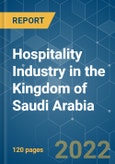Though the increasing religious travel to the country is encouraging investments, the hospitality industry in Saudi Arabia is recording dynamic key performance indicators from the past five years. The kingdom is focusing on improving investment opportunities through the introduction of several projects. Qiddiya, The Red Sea Development, Amaala, NEOM, Al Ula, Wadi Al Disah Development are the major projects launched by the Public Investment Fund of Saudi Arabia in 2018 and are aiming at fulfilling the target Vision 2030. The increasing religious and leisure travel to the Kingdom has opened investment opportunities in the hospitality industry and resulted in an increasing number of new hotels opening in the key cities. The top-performing international brands opened more than 20 new hotels a few directly with their brand name and a few through strategic partnerships with the leading domestic hospitality groups and added more than 8,200 rooms/keys to the existing supply covering all segments of the market. Jeddah recorded the highest average daily revenue value among the top competitive markets across the globe with USD 284. Makkah, Riyadh and Dammam/ Al Khobar are also among the top 10 locations that recorded the highest average daily revenue across the world with USD 176, USD 170 and USD 132 respectively during 2018 making the region an attractive market for investors.
Key Market Trends
International Visitors to Saudi Arabia are Expected to Rise After the Kingdom’s New Visa Regime 2019
In September 2019, Saudi Arabia announced its new visa regime in which it announced that it is going to provide e-visas and visas on arrival to visitors from 49 countries. Till September 2019, the travel to Saudi Arabia was entirely restricted to expatriate workers and people with business visas, and to the religious pilgrims, who are visiting the holy cities of Saudi Arabia - Mecca and Medina. The kingdom has relaxed the entry with a view to attracting more visitors to achieve its target of welcoming 100 million visitors by 2030.
The High International Overnight Visitor Spending Records are Attracting Investments
Despite the dynamic yet challenging market conditions, Saudi Arabia remained one of the most competitive markets for the hospitality industry in the world. As per STR, in 2019, Jeddah reported the highest average daily revenue globally. Mastercard Global Destination Cities Index revealed that Makkah achieved the second-highest spend per visitor globally during the same year. These indicate that the overall long-term outlook for the hospitality industry in Saudi Arabia has great potential for diversification efforts with the ongoing government-led investments in infrastructure and several social reforms in the entertainment and the tourism sector.
Competitive Landscape
The hospitality industry in Saudi Arabia is a combination of several international brands and chain hotels and several domestically grown chain hotels. Many well-established international brands entered several strategic partnership programs with the leading hospitality companies that have the Middle East origination and are operating through their brand name under the management contracts of reputed organizations. The market holds great growth opportunities and is welcoming many new investors into the industry.
Additional Benefits:
- The market estimate (ME) sheet in Excel format
- 3 months of analyst support
This product will be delivered within 2 business days.
Table of Contents
Methodology

LOADING...








